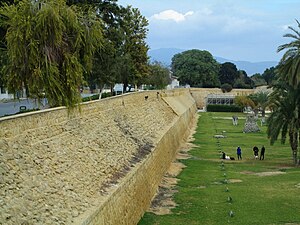Venetian walls of Nicosia
| Walls of Nicosia | |
|---|---|
| Nicosia, Cyprus and North Nicosia, Northern Cyprus | |

Part of the Venetian walls
|
|

Map showing Nicosia in 1597
|
|
| Coordinates | 35°10′15.8″N 33°22′12.2″E / 35.171056°N 33.370056°E |
| Type | City wall and star fort |
| Site information | |
| Owner | Government of Cyprus |
| Controlled by | Department of Antiquities |
| Open to the public |
Yes |
| Condition | Largely intact |
| Architect | Giulio Savorgnano |
| Site history | |
| Built | 1567–1570 |
| Built by | Republic of Venice |
| Battles/wars | Ottoman–Venetian War (1570–73) |
The Venetian Walls are a series of defensive walls which surround the capital city of Nicosia in Cyprus. The first city walls were built in the Middle Ages, but they were completely rebuilt in the mid-16th century by the Republic of Venice. The walls are still largely intact, and are among the best preserved Renaissance fortifications in the Eastern Mediterranean. They are a major tourist attraction.
The city of Nicosia, along with Valletta in Malta, was considered to be a practical example of an ideal city of the Renaissance, and this was due to its fortifications as well as the urban life within the city.
The first fortification in Nicosia was a castle built in 1211, during the Lusignan period. A large tower called Margarita Tower was built by King Peter I in 1368. Peter II built the first fortifications surrounding the entire city, and also demolished the Margarita Tower.
Cyprus became part of the Republic of Venice in 1489. Although the Venetian governors of the city emphasized the need for the city to be fortified, initially nothing was done to improve the fortifications. This changed following the Great Siege of Malta in 1565, when fears of Ottoman expansion increased and many Christian states in the Mediterranean began to strengthen their fortifications.
In 1567, the Venetians decided to fortify the city, and commissioned the Italian military engineers Giulio Savorgnano and Franscesco Barbaro to design the new fortifications. The medieval fortifications, which engineers had deemed inadequate to defend the city, were demolished to make way for the new walls. The Venetians also demolished several houses, churches and palaces within the city as well as buildings lying outside the new walls, both for the acquisition of building materials and for a clearer field of vision for the defence of the city.
At the same time, the Pedieos River was diverted outside the city to protect the residents from flooding and to fill the moat encircling the new walls.
...
Wikipedia
